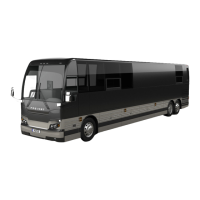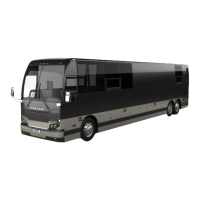DOB 1300-1556 | X3-45 Commuter PA-1648 Maintenance Manual First release Oct 2020
6. If bubbles appear at the exhaust port, this is
an indication that the exhaust valve
assembly is defective and must be replaced.
7. If bubbles appear around edge of valve
cover plate, the cover plate gasket must be
replaced.
8. If no leaks are found, remove valve
assembly from water, then with air pressure
still connected to the air spring port, actuate
control arm to remove any excess water
which may have entered exhaust valve
chamber. Remove air line, connect it to the
air inlet port, and repeat operation to remove
water from the air inlet valve chamber.
7. FRONT KNEELING SYSTEM
The kneeling system is used to lower front of
vehicle. This allows passengers to board the
vehicle with greater ease. The kneeling action is
achieved by exhausting air from the front air
springs (bellows). This system bypasses the
height control valve to provide a fast up and
down movement of the front suspension. Only
seven seconds are required to lower vehicle
from normal level to the lowered position, and
approximately the same time to raise the vehicle
back to normal level. The quick response is
achieved by the kneeling air tank installed in
front of the I-beam front axle (for exact position,
refer to Section 12, “Brake and Air System”).
This tank provides sufficient air supply to the
kneeling system for some successive
operations. The system is provided with two
safety features; first, a speed switch will enable
the kneeling system to work only below 5 mph (8
km/h). Secondly, the parking brake is
automatically applied, and a limit switch will keep
it applied as long as the vehicle has not returned
to a certain height where the driver will be able to
manually remove the parking brake.
7.1 PRINCIPLE OF OPERATION
Refer to the air system schematic diagram
annexed at the end of Section 12, “Brake and Air
System”.
DOWN (FRONT KNEELING)
Both the air spring control and air spring exhaust
solenoid valves are energized, so the air control
valves release air from front air springs. The
height control valve is bypassed to ensure no air
is forwarded to air springs while lowering the
front suspension.
UP (FRONT KNEELING)
Only the air spring control solenoid valve is
energized, so the air coming from the kneeling
air tank is routed through air control valves, and
up to front air springs.
The height control valve is bypassed until the
kneeling proximity switch signals the kneeling
module to cut off the air spring control solenoid
valve, about 1" (25 mm) below normal ride
height. The final height adjustment is achieved
by the height control valve.
7.2 MAINTENANCE
For diagnosis and understanding of the system,
refer to wiring diagrams and Section 06,
“Electrical System”, and to the appropriate air
system schematic diagram annexed to Section
12, “Brake and Air System”.
7.3 AIR SPRING CONTROL SOLENOID
VALVES (REMOVAL & INSTALLATION)
1. On the rear side of steering compartment,
locate both the air spring control and air
spring exhaust solenoid valves.
2. Identify hoses and wires to ease
reinstallation. Disconnect solenoid wires and
the three flexible black hoses from solenoid
valves.
3. Unscrew and remove the control solenoid
valve and exhaust solenoid valve assembly.
Place on a clean working place.
Reverse removal procedure to reinstall.
CAUTION
Always adjust on "fill cycle". If it is necessary to
lower vehicle height, release sufficient air to be
well below height, then adjust to height.
7.4 ACCESSORY AIR TANK
MAINTENANCE
Ensure that the accessory air tank is purged
during pre-starting inspection. A good practice is
to purge this tank at the end of every driving day
by the remote air tank drain valve located in the
service compartment.
Moreover, purge all tanks by their bottom drain
valves at specified intervals refer to Section 12,
“Brake and Air System” for more information
regarding air tanks location and function.

